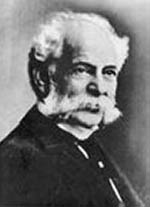|
Battle Of Dermbach
The Battle of Dermbach was the first clash between Prussian and Bavarian troops in the Austro-Prussian War near Dermbach, Saxe-Weimar-Eisenach in modern-day Thuringia on 4 July 1866. On the Prussian side, the 13th Division under Lieutenant General von Goeben was deployed which faced parts of the 3rd and 4th Bavarian infantry divisions with a total strength of approx. 15,000 men. The Commander-in-Chief on the Bavarian side was Prince Karl. Starting Positions The Prussian Main Army, formed from three divisions under the command of General Eduard von Falckenstein, had been advancing from Eisenach towards Fulda since 1 July. This was also the aim of the Bavarian Army, which wanted to unite there with the allied 8th Federal Corps (contingents from Baden, Württemberg, Hesse-Darmstadt, Hesse-Kassel, the Nassau and Austria). On 2 and 3 July there had already been minor skirmishes between the Prussian and Bavarian armies near Immelborn and Dermbach. Falckenstein believed that he wa ... [...More Info...] [...Related Items...] OR: [Wikipedia] [Google] [Baidu] |
Austro-Prussian War
The Austro-Prussian War, also by many variant names such as Seven Weeks' War, German Civil War, Brothers War or Fraternal War, known in Germany as ("German War"), (; "German war of brothers") and by a variety of other names, was fought in 1866 between the Austrian Empire and the Kingdom of Prussia, with each also being aided by various allies within the German Confederation. Prussia had also allied with the Kingdom of Italy, linking this conflict to the Third Independence War of Italian unification. The Austro-Prussian War was part of the wider rivalry between Austria and Prussia, and resulted in Prussian dominance over the German states. The major result of the war was a shift in power among the German states away from Austrian and towards Prussian hegemony. It resulted in the abolition of the German Confederation and its partial replacement by the unification of all of the northern German states in the North German Confederation that excluded Austria and the other Sou ... [...More Info...] [...Related Items...] OR: [Wikipedia] [Google] [Baidu] |
Grand Duchy Of Hesse
The Grand Duchy of Hesse and by Rhine (german: link=no, Großherzogtum Hessen und bei Rhein) was a grand duchy in western Germany that existed from 1806 to 1918. The Grand Duchy originally formed from the Landgraviate of Hesse-Darmstadt in 1806 as the Grand Duchy of Hesse (german: Großherzogtum Hessen, link=no). It assumed the name Hesse and bei Rhein in 1816 to distinguish itself from the Electorate of Hesse, which had formed from neighbouring Hesse-Kassel. Colloquially, the grand duchy continued to be known by its former name of Hesse-Darmstadt. In 1806, the Landgraviate of Hesse-Darmstadt seceded from the Holy Roman Empire and joined Napoleon's new Confederation of the Rhine. The country was promoted to the status of Grand Duchy and received considerable new territories, principally the Duchy of Westphalia. After the French defeat in 1815, the Grand Duchy joined the new German Confederation. Westphalia was taken by Prussia, but Hesse received Rheine-Hesse in return. A ... [...More Info...] [...Related Items...] OR: [Wikipedia] [Google] [Baidu] |
Battles Of The Austro-Prussian War
The Austro-Prussian War, also by many variant names such as Seven Weeks' War, German Civil War, Brothers War or Fraternal War, known in Germany as ("German War"), (; "German war of brothers") and by a variety of other names, was fought in 1866 between the Austrian Empire and the Kingdom of Prussia, with each also being aided by various allies within the German Confederation. Prussia had also allied with the Kingdom of Italy, linking this conflict to the Third Independence War of Italian unification. The Austro-Prussian War was part of the wider rivalry between Austria and Prussia, and resulted in Prussian dominance over the German states. The major result of the war was a shift in power among the German states away from Austrian and towards Prussian hegemony. It resulted in the abolition of the German Confederation and its partial replacement by the unification of all of the northern German states in the North German Confederation that excluded Austria and the other Southern ... [...More Info...] [...Related Items...] OR: [Wikipedia] [Google] [Baidu] |
Heinz Helmert
The H. J. Heinz Company is an American food processing company headquartered at One PPG Place in Pittsburgh, Pennsylvania. The company was founded by Henry J. Heinz in 1869. Heinz manufactures thousands of food products in plants on six continents, and markets these products in more than 200 countries and territories. The company claims to have 150 number-one or number-two brands worldwide. Heinz ranked first in ketchup in the US with a market share in excess of 50%; the Ore-Ida label held 46% of the frozen potato sector in 2003. Since 1896, the company has used its "57 Varieties" slogan; it was inspired by a sign advertising 21 styles of shoes, and Henry Heinz chose the number 57 even though the company manufactured more than 60 products at the time, because "5" was his lucky number and "7" was his wife's. In February 2013, Heinz agreed to be purchased by Berkshire Hathaway and the Brazilian investment firm 3G Capital for $23billion. On March 25, 2015, Kraft announced its me ... [...More Info...] [...Related Items...] OR: [Wikipedia] [Google] [Baidu] |
Daheim (Zeitschrift) in Millbrook, New York
{{disambiguation, surname ...
Daheim may refer to: * Mary Daheim (born 1937), American novelist * John Daheim (1916–1991), American stuntman and actor * '' Daheim'', German magazine * "Daheim", the actual name of the Hitchcock Estate The Hitchcock Estate in Millbrook, New York is a historic mansion and surrounding grounds, associated with Timothy Leary and the psychedelic movement. It is often referred to in this context as just Millbrook; it is also sometimes called by its o ... [...More Info...] [...Related Items...] OR: [Wikipedia] [Google] [Baidu] |
Theodor Fontane
Theodor Fontane (; 30 December 1819 – 20 September 1898) was a German novelist and poet, regarded by many as the most important 19th-century German-language realist author. He published the first of his novels, for which he is best known today, only at age 58 after a career as a journalist. Fontane's novels are known for their complex, often sceptical view of society in the German empire; he shows different social and political parts of society meeting and sometimes clashing. Other trademarks of Fontane's work are their strongly drawn female characters (such as '' Effi Briest'' and ''Frau Jenny Treibel''), tender irony and vivid conversations between characters. Life Youth Fontane was born in Neuruppin, a town 30 miles northwest of Berlin, into a Huguenot family. At the age of sixteen he was apprenticed to an apothecary, his father's profession. He became an apothecary himself and in 1839, at the age of 20, wrote his first work (''Heinrichs IV. erste Liebe'', now lost). ... [...More Info...] [...Related Items...] OR: [Wikipedia] [Google] [Baidu] |
Battle Of Königgrätz
The Battle of Königgrätz (or Sadowa) was the decisive battle of the Austro-Prussian War in which the Kingdom of Prussia defeated the Austrian Empire. It took place on 3 July 1866, near the Bohemian city of Hradec Králové (German: Königgrätz) and village of Sadová, now in the Czech Republic. Prussian forces, totaling around 285,000 troops, used their superior training and tactical doctrine and the Dreyse needle gun to win the battle and the entire war at Königgrätz on their own. Prussian artillery was ineffective and almost all of the fighting on the Prussian side was done by the First Army under Prince Friedrich Karl and one division from the Second Army. The Prussian 7th Infantry Division and 1st Guards Infantry Division attacked and destroyed 38 out of 49 infantry battalions of four Austrian corps at the Swiepwald and Chlum at the center of the battlefield, deciding the outcome of the struggle and forcing an Austrian retreat at 15:00, before any Prussian reinfor ... [...More Info...] [...Related Items...] OR: [Wikipedia] [Google] [Baidu] |
Kaltennordheim
Kaltennordheim () is a town in the Schmalkalden-Meiningen district, in Thuringia, Germany. It is situated in the Rhön Mountains, 22 km southwest of Bad Salzungen, and 35 km east of Fulda. The former municipalities Aschenhausen, Kaltensundheim, Kaltenwestheim, Melpers, Oberkatz und Unterweid were merged into Kaltennordheim in January 2019. At the same time, Kaltennordheim passed from the Wartburgkreis to Schmalkalden-Meiningen. Origin of the Name The location was named "Nordheim im Tullifeld" in the middle ages. The prefix "Kalten-" first appeared in the 14th century, likely in reference to the relatively harsh weather in the region which can be attributed to its position south of the Neuberg Dermbach mountain range. Three other nearby towns bear the same prefix: Kaltensundheim, Kaltenlengsfeld and Kaltenwestheim. The prefix also differentiates Kaltennordheim from other towns like Nordheim vor der Rhön. History Within the German Empire (1871-1918), Kaltennordheim wa ... [...More Info...] [...Related Items...] OR: [Wikipedia] [Google] [Baidu] |
Wiesenthal
Wiesenthal (German for "meadow valley") is a Municipalities in Germany, municipality in the Wartburgkreis Districts of Germany, district of Thuringia, Germany. References Wartburgkreis {{Wartburgkreis-geo-stub ... [...More Info...] [...Related Items...] OR: [Wikipedia] [Google] [Baidu] |
Neidhartshausen
Neidhartshausen is a village and a former municipality in the Wartburgkreis district of Thuringia, Germany. Since 1 January 2019, it is part of the municipality Dermbach Dermbach is a municipality in the Wartburgkreis district of Thuringia, Germany. The former municipalities Brunnhartshausen, Diedorf, Neidhartshausen, Stadtlengsfeld, Urnshausen and Zella/Rhön Zella/Rhön is a village and a former municipal .... References Wartburgkreis Former municipalities in Thuringia {{Wartburgkreis-geo-stub ... [...More Info...] [...Related Items...] OR: [Wikipedia] [Google] [Baidu] |
Zella/Rhön
Zella/Rhön is a village and a former municipality in the Wartburgkreis district of Thuringia, Germany Germany, officially the Federal Republic of Germany (FRG),, is a country in Central Europe. It is the most populous member state of the European Union. Germany lies between the Baltic and North Sea to the north and the Alps to the sou .... Since 1 January 2019, it is part of the municipality Dermbach. References Rhön Mountains Wartburgkreis Former municipalities in Thuringia {{Wartburgkreis-geo-stub ... [...More Info...] [...Related Items...] OR: [Wikipedia] [Google] [Baidu] |




.jpg)